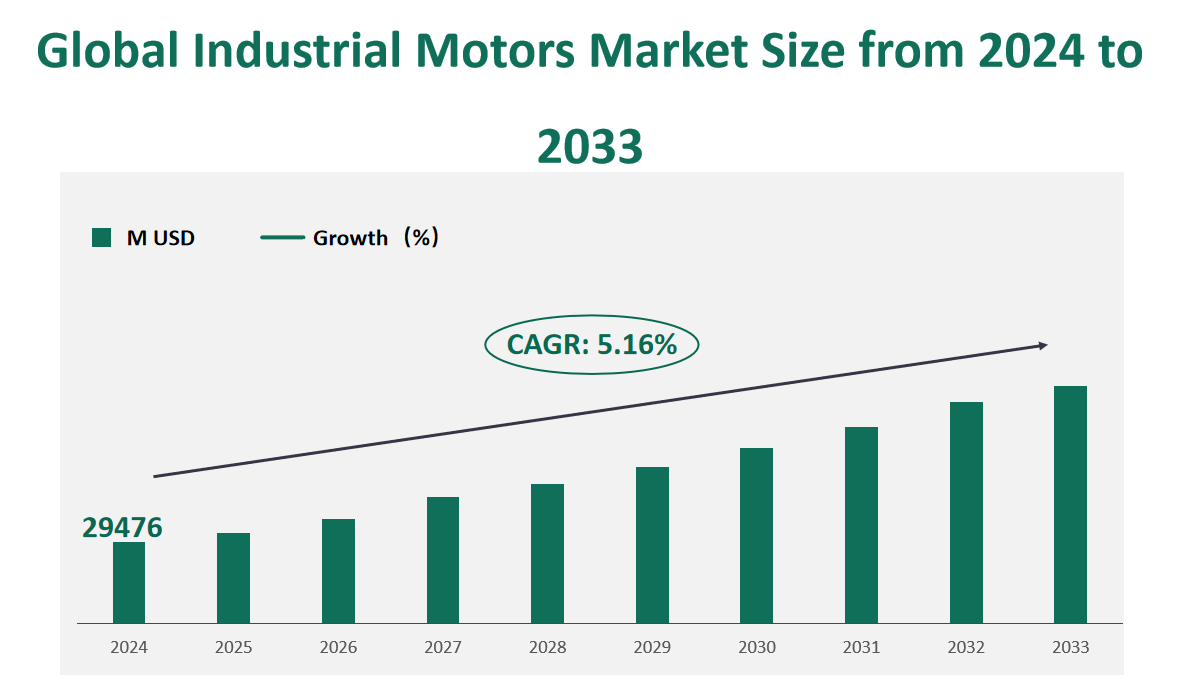1 Global Industrial Motors Market Insight Analysis
The total value of the global industrial motors market is projected to be $29,476 million in 2024. According to the report, the CAGR of the industrial motors market from 2024 to 2033 is 5.16%.
Industrial motors are defined as motors used in the industrial sector to convert electrical energy into mechanical energy, with specific applications including pumps, fans, conveyor belts, and compressors. These motors play a crucial role in various industries such as oil and gas, power generation, mining and metals, and industrial machinery. As the global industrialization process deepens and new technologies continue to emerge, the demand for industrial motors is expected to keep growing. Additionally, the global energy transition and the development trend of high-efficiency motors will further promote industry growth.
Figure Global Industrial Motors Market Size (M USD) and CAGR (2024-2033)

2 Industrial Motors Market Growth Drivers and Restraints
The growth of the industrial motors market is driven by several factors. Firstly, the broad downstream demand is the main driver of market growth. Industrial motors serve as a power source in various industrial fields, driving the operation of various mechanical equipment. Secondly, the growth of demand in emerging markets also brings new growth points to the industry. For example, the rapid development of new energy vehicles and energy storage power generation fields has increased the demand for industrial motors.
However, market growth also faces some limiting factors. Fluctuations in raw material prices pose challenges to manufacturers’ cost control. In addition, industry barriers and technical barriers limit opportunities for new entrants, making market competition more intense. Technical barriers require companies to have a high level of professional knowledge and practical experience, while brand and capital barriers require companies to have sufficient funds and a market validation period. These factors work together to affect the growth potential of the industrial motors market.
3 Technological Innovations and Mergers in the Industrial Motors Market
Technological innovation in the industrial motors market mainly focuses on improving the efficiency and performance of motors. With the global trend towards energy conservation, emission reduction, and electrification, the industrial motors industry is moving towards high efficiency, energy saving, and integration.
Corporate mergers and restructuring activities are frequent, aimed at strengthening market positions and expanding product lines. For example, Hitachi Energy completed the acquisition of COET to strengthen its global position in high-power electric vehicle charging infrastructure, power electronics, and grid edge. In addition, Allied Motion expanded its motion system solution capabilities by acquiring ORMEC Systems Corp. These mergers and restructuring activities not only enhance the market competitiveness of companies but also promote technological progress and innovation in the industry.
4 Global Industrial Motors Market Size by Type
In 2024, the global industrial motors market size segmented by type is as follows: the high voltage motor market revenue is $6,060 million, the medium voltage motor market revenue is $4,666 million, and the low voltage motor market revenue is $18,750 million. High voltage motors are typically used in environments with voltages exceeding 35KV and are suitable for applications requiring high voltage operation. Medium voltage motors have a voltage range between 1000V and 35KV and are suitable for industrial applications with medium voltage requirements. Low voltage motors are used in environments with voltages below 1000V and are the most widely used type of motor in the market.
Table Global Industrial Motors Market Size and Share by Type in 2024
|
Type |
Market Size (M USD) 2024 |
Market Share 2024 |
|---|---|---|
|
High Voltage Motor |
6060 |
20.56% |
|
Medium Voltage Motor |
4666 |
15.83% |
|
Low Voltage Motor |
18750 |
63.61% |
5 Global Industrial Motors Market Size by Application
The global industrial motors market is segmented by application, with each segment experiencing unique growth dynamics. In 2024, the market revenue for different applications is forecasted as follows: Oil & Gas at $3,783 million, Power Generation at $3,214 million, Mining & Metal at $1,574 million, Industrial Machinery at $6,152 million, Water Pump at $4,601 million, Fan at $3,438 million, and Others at $6,714 million.
The Oil & Gas application is a significant contributor to the market, with a substantial revenue share due to the critical role industrial motors play in powering equipment in this sector. Power Generation follows closely, reflecting the essential function of motors in electricity production facilities. The Mining & Metal segment benefits from the robustness of industrial motors in heavy-duty applications, while Industrial Machinery represents the largest application area, showcasing the versatility of these motors across various manufacturing processes.
Water Pump and Fan applications also hold considerable market shares, indicating the widespread use of industrial motors in fluid handling and ventilation systems. The ‘Others’ category encompasses a diverse range of applications, highlighting the motors’ adaptability to different industrial needs. These detailed data points underscore the industrial motors’ critical role across various sectors and their significant market presence in 2024.
Table Global Industrial Motors Market Size and Share by Application in 2024
|
Application |
Market Size (M USD) 2024 |
|---|---|
|
Oil & Gas |
3783 |
|
Power Generation |
3214 |
|
Mining & Metal |
1574 |
|
Industrial Machinery |
6152 |
|
Water Pump |
4601 |
|
Fan |
3438 |
|
Others |
6714 |
6 Global Industrial Motors Market Size by Region
North America is anticipated to generate a market revenue of $8,445 million in 2024, with the United States and Canada being the primary drivers of this revenue. The region’s robust industrial base and ongoing technological advancements contribute to its substantial market share. The market in North America is characterized by a high demand for high-efficiency and technologically advanced motors, driven by stringent energy efficiency regulations and a focus on sustainable industrial practices.
Europe is projected to have a market revenue of $7,597 million in 2024. The European market is influenced by a strong emphasis on energy efficiency and environmental sustainability. The region’s market is driven by countries such as Germany, the United Kingdom, and France, which have significant industrial sectors and are at the forefront of adopting innovative motor technologies.
China is expected to lead with a market revenue of $5,878 million in 2024, reflecting its rapid industrialization and economic growth. China’s market is characterized by a large-scale manufacturing sector and a growing demand for industrial motors across various applications. The country’s strategic focus on becoming a global manufacturing hub has positioned it as a key player in the industrial motors market.
Japan is forecasted to have a market revenue of $2,256 million in 2024. The Japanese market is known for its precision engineering and high-quality motor manufacturing. Despite its smaller market size compared to China, Japan’s contribution is significant due to its advanced technology and high demand for specialized motors in industries such as robotics and automotive manufacturing.
The Middle East and Africa are expected to generate a market revenue of $1,301 million in 2024. The region’s market is influenced by the oil and gas industry, which is a major consumer of industrial motors. The Middle East’s economic growth and infrastructure development are driving factors behind the increasing demand for industrial motors.
India is projected to have a market revenue of $797 million in 2024. India’s market is characterized by a growing industrial sector and a focus on economic development. The country’s large population and expanding middle class are driving the demand for industrial motors in various sectors, including manufacturing, agriculture, and infrastructure.
South America and South Korea are also significant contributors to the global industrial motors market, with revenues forecasted at $1,071 million and $676 million, respectively, in 2024. South America’s market is influenced by its natural resources and growing industrialization, while South Korea’s market is driven by its advanced technology sector and focus on innovation.
Southeast Asia is expected to generate a market revenue of $958 million in 2024, reflecting the region’s rapid economic growth and industrial expansion. Countries such as Indonesia, Thailand, and Vietnam are experiencing increased demand for industrial motors due to their burgeoning manufacturing sectors and infrastructure development.
Figure Global Industrial Motors Market Size (M USD) by Region in 2024

7 Global Industrial Motors Market Analysis by Major Players
7.1 ABB
Company Introduction and Business Overview:
ABB, established in 1988 and headquartered in Switzerland, is a global technology leader in electrification and automation. The company operates worldwide, connecting engineering know-how and software to optimize manufacturing, movement, power, and operation processes.
ABB’s solutions are designed to enable a more sustainable and resource-efficient future. The company’s product offerings include a wide range of industrial motors, with a focus on high-voltage modular induction motors that offer high reliability, availability, and efficiency in demanding applications.
Products:
ABB’s high voltage modular induction motors are designed for wide power range operations and excellent starting performance. These motors are available globally and are customizable to meet the needs of various industry segments and applications.
Market Performance in 2024:
In 2024, ABB is projected to achieve a revenue of $5,568.13 million from its industrial motors division, with a gross margin of 34.27%.
7.2 Siemens
Company Introduction and Business Overview:
Siemens, founded in 1847 and headquartered in Germany, is a leading technology company with operations spanning electrification, automation, and digitalization. Siemens has a global presence, serving customers in various industries such as energy, healthcare, infrastructure, process and manufacturing, and others.
Siemens designs, develops, and manufactures products, installs complex systems and projects, and provides a wide range of customized solutions. The company focuses on power generation and distribution, intelligent infrastructure for buildings and distributed energy systems, and smart mobility solutions.
Products:
Siemens offers a comprehensive range of low voltage motors, including general purpose motors, severe duty LV motors, explosion proof LV motors, and high-torque motors. These motors are designed for reliability, efficiency, and robustness, suitable for various industrial applications.
Market Performance in 2024:
Siemens is expected to generate a revenue of $2,684.15 million from its industrial motors business in 2024, with a gross margin of 30.88%.
7.3 Toshiba
Company Introduction and Business Overview:
Toshiba, established in 1882 and headquartered in Japan, is a diversified enterprise involved in electronics, electrical equipment, and information technology. The company has a global sales region and is known for its design, development, production, and sales of various electronic devices and systems.
Toshiba’s product portfolio includes storage devices, point-of-sale (POS) systems, energy-saving products and services, semiconductors, semiconductor manufacturing equipment, microwave semiconductors and components, tablets, home appliances products, power systems, transmission and distribution systems, and water treatment systems.
Products:
Toshiba’s industrial motors include the EQP Global SD series, which features oversized bearings, low vibration, heavy-duty construction, and high torque output. These motors are designed for long-lasting performance and are optimized for adjustable speed drive (ASD) use.
Market Performance in 2024:
In 2024, Toshiba is forecasted to have a revenue of $2,457.14 million from its industrial motors division, with a gross margin of 34.54%.





